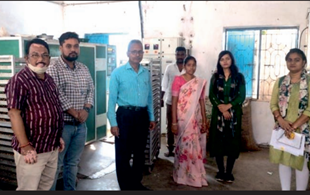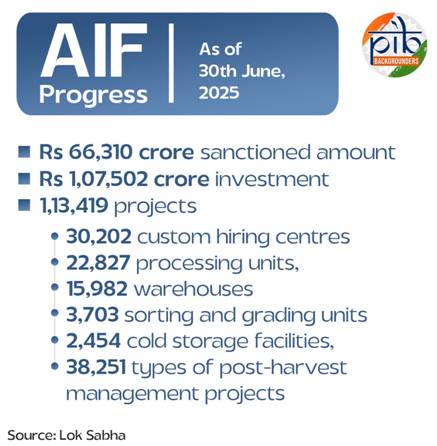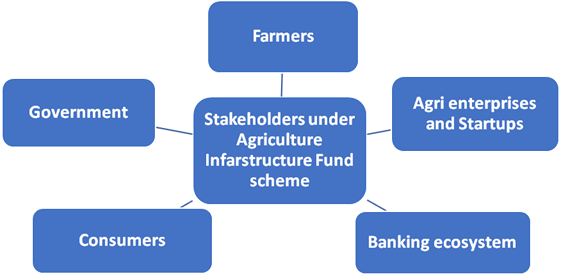Farmer's Welfare
Agriculture Infrastructure Fund
Boosting Agri Infra for Better Productivity
Posted On: 09 AUG 2025 9:37AM
- Infrastructure Growth: Rs 66,310 crore sanctioned for 1.13 lakh Agri-projects under AIF, boosting post-harvest infrastructure.
- Benefits to Farmers: Improved storage, better prices, reduced losses, and increased income for farmers.
- Expanded Scope: Now includes integrated processing units, solar integration (PM-KUSUM Component-A), and extended credit guarantees for FPOs from NAB Sanrakshan.
- Supporting Schemes: AMI, MOVCDNER, DPI, PMMSY, e-NAMand MIF complement AIF in strengthening rural Agri-ecosystems.
Introduction
In the heart of Kidigam, Gajapati District, Odisha, the Sri Maa Majji Gouri Cashew Industry stands as a powerful visionary entrepreneurship. Established in 2022, this enterprise was born out of a bold vision—to create a primary cashew processing unit that would generate local employment and provide market stability to farmers. With a total project cost of Rs 57 lakh, the promoters secured a loan of Rs 42.75 lakh from UCO Bank at a highly subsidized interest rate of 5.5% per annum, made possible through the Agriculture Infrastructure Fund (AIF).
Backed by this timely and affordable financing, the unit today offers direct employment to 20 individuals and supports 40 local farmers, who now benefit from assured procurement of their produce. With an expected annual revenue of Rs 2.48 crore, the enterprise is not just a source of income—it is a cornerstone of community development and agricultural progress.

This story reflects the broader impact and intent of the Agriculture Infrastructure Fund (AIF), a flagship scheme launched in 2020–21 by the Government of India to strengthen post-harvest and farm-gate infrastructure. Recognizing that agricultural infrastructure is key to improving productivity, reducing post-harvest losses, enhancing market access, and ensuring food security, AIF aims to boost farmer income through value addition and efficient logistics.
Agriculture Infrastructure Fund (AIF) was launched to strengthen agricultural infrastructure across India. It is a medium-long term debt financing facility through interest subvention and credit guarantee support on loans for investment in viable projects for post-harvest management infrastructure and viable farming assets. The scheme focuses on the creation of farm-gate storage and logistics facilities to help farmers store their produce effectively and sell it at better prices by minimizing post-harvest losses and reducing dependence on intermediaries. Infrastructure such as warehouses, cold storage, sorting and grading units, and ripening chambers enhances farmers’ ability to access wider markets and improve value realization, thereby boosting their income. Designed to benefit all stakeholders—including farmers, agri-entrepreneurs, cooperatives, and consumers—the scheme aims at the holistic development of the agriculture sector.
Under AIF, a loan provision of Rs 1 lakh crore has been made through lending institutions, with a capped interest rate of 9% on loans. The scheme is operational for a period of 13 years, from 2020–21 to 2032–33. However, loan disbursement under the scheme will complete in six years i.e. by the end of FY 2025-26. All loans under this financing facility have interest subvention of 3% per annum up to a loan limit of Rs 2 crores. This interest subvention is available for a maximum period of 7 years. In case of loans beyond Rs 2 crores, interest subvention is limited up to Rs 2 crores.
Credit guarantee coverage is also available for eligible borrowers from this financing facility under Credit Guarantee Fund Trust for Micro and Small Enterprises (CGTMSE) scheme for a loan up to Rs 2 crores. The fee for this coverage is borne by the Government.
Moreover, the development of agricultural infrastructure can mitigate the impact of natural uncertainties, bridge regional disparities, support skill development, and promote the sustainable use of limited land resources—ultimately contributing to a more resilient and productive agricultural ecosystem.
As of30th June, 2025, a total of Rs 66,310 crore has been sanctioned under the Agriculture Infrastructure Fund (AIF) for 1,13,419 projects across India. These projects have successfully mobilized an investment of Rs 1,07,502 crore in the agriculture sector. Also, a total of 2,454 cold storage projects has been sanctioned under the AIF, with a cumulative sanctioned amount of Rs 8,258 crore.This large-scale infrastructure push is expected to enhance storage, reduce wastage, improve value addition, and ultimately increase farmer incomes.

Objectivesfor Stakeholders under AIF Scheme
The scheme is designed to benefit all stakeholders in the agricultural ecosystem individual farmers, FPOs, cooperatives, agri-entrepreneurs, and even consumers through the creation of sustainable, scalable infrastructure that supports value chain efficiency

Farmers (including FPOs, PACS, Marketing and Multipurpose Cooperative Societies, State Agencies, Agricultural Produce Market Committees (Mandis), National & State Federations of Cooperatives, Federation of FPOs and Federations of Self Help Groups (SHGs) etc)
- Improved marketing infrastructure enables direct sales to a wider consumer base, increasing income.
- Better logistics reduce post-harvest losses and dependence on intermediaries.
- Access to cold storage and packaging allows farmers to choose optimal selling time for better price realization.
- Community farming assets enhance productivity and reduce input costs.
Government
- Enables priority sector lending in previously unviable Agri-projects through interest subvention and credit guarantees.
- Helps reduce national food wastage and aligns India’s Agri-sector with global standards.
- Facilitates development of PPP models for Agri-infrastructure at central, state, and local levels.
Agri-entrepreneurs and Startups
- Dedicated funding support drives innovation and adoption of technologies like IoT and AI etc.
- Enhances collaboration between entrepreneurs and farmers across the Agri-value chain.
Banking Ecosystem
- Reduced lending risk due to interest subvention, convergence and credit guarantees.
- Helps banks expand their Agri-lending portfolio and customer base.
- Refinance facility boosts the role of cooperative banks and Regional Rural Banks (RRBs).
Consumers
- More produce reaches markets due to reduced inefficiencies in the supply chain.
- Improved quality and availability of agricultural products at better prices.
Expanding Agricultural Infrastructure Fund scheme
Marking a crucial milestone in India's mission to transform its agricultural sector, on August 28, 2024, the Union Cabinetapproved a significant expansion of the Agricultural Infrastructure Fund (AIF) scheme. This decision introduces a series of measures designed to make the AIF more attractive, impactful, and inclusive, reflecting the government's commitment to enhancing agricultural productivity and infrastructure. The goal is to build robust Agri-infrastructure that directly supports farmers and agrarian enterprises across India.
The measures aimed at making the scheme more impactful, and inclusive are as follows:
- Viable projects for community farming infrastructure are now eligible under AIF.
- The primary and secondary processing projects integrated as a single unit are eligible.Standalone secondary processing projects remain ineligible.
- AIF support extended to solar projects under PM-KUSUM Component-A by eligible entities like FPOs, cooperatives, and panchayats.
- The government has extended AIF credit guarantee coverage for Farmer Producer Organization (FPOs) through NABSanrakshan Trustee Company Pvt. Ltd., in addition to Guarantee Fund Trust for Micro and Small Enterprises(CGTMSE). This aims to improve the financial security and creditworthiness and boost their access to credit and encourage investment in agricultural infrastructure.
- Encourages the development of solar-powered and climate-resilient agricultural facilities.
Key Government Initiatives of Boosting Agri Infrastructure
The Government of India has launched several targeted schemes to develop and modernize agricultural infrastructure, reduce post-harvest losses, improve value addition, and enhance farmer incomes.
Integrated Cold Chain, Food Processing and Preservation Infrastructure Scheme
The Ministry of Food Processing Industries (MoFPI) implements the Integrated Cold Chain, Food Processing and Preservation Infrastructure Scheme, a key component of the Pradhan Mantri Kisan Sampada Yojana (PMKSY). The scheme aims to reduce post-harvest losses of both horticultural and non-horticultural produce, while ensuring remunerative prices for farmers by improving storage, transportation, and processing infrastructure.
Under this scheme, grant-in-aid is provided at the rate of 35% for general areas and 50% for North Eastern, Himalayan States, ITDP areas, and Islands for storage and transport infrastructure. For value addition and processing infrastructure, the assistance increases to 50% and 75% respectively, subject to a maximum of Rs 10 crore per project. The scheme supports integrated cold chain projects, including irradiation facilities, but excludes standalone cold storages from its coverage. This initiative plays a crucial role in building efficient farm-to-market linkages and reducing wastage in the Agri-value chain.Top of Form
Capital Investment Subsidy for Modernization of Cold Storages and Storages for Horticulture Products.
The scheme aims to strengthen the cold chain infrastructure for horticultural produce by offering credit-linked back-ended subsidies. The subsidy is provided at the rate of 35% of the capital cost in general areas and 50% in North Eastern, hilly, and scheduled areas. It supports the construction, expansion, and modernization of cold storages and Controlled Atmosphere (CA) storages with a capacity ranging from 5,000 MT to 20,000 MT. The scheme plays a vital role in reducing post-harvest losses, maintaining the quality of perishable produce, and improving shelf life and marketability of horticultural products.Bottom of Form
Agricultural Marketing Infrastructure (AMI)
The Union Government is implementing the Agricultural Marketing Infrastructure (AMI) scheme, which is a key component of the Integrated Scheme for Agricultural Marketing (ISAM). The objective of the AMI scheme is to strengthen agricultural marketing infrastructure across rural India by providing financial assistance for the construction and renovation of godowns and warehouses.
As of June 30, 2025, a total of 49,796 storage infrastructure projectshas been sanctioned across 27 states in India. These projects collectively contribute to a storage capacity of 982.94 lakh MT and to support these initiatives, a total subsidy of Rs 4,829.37 crore has been disbursed.
Mission for Integrated Development of Horticulture (MIDH)
Under the Mission for Integrated Development of Horticulture (MIDH), financial assistance is provided for setting up post-harvest infrastructure like pack houses, cold storages, refrigerated transport, and processing units.Support for food processing units is specifically extended to the North Eastern and Himalayan States. The assistance is offered at 35% of the project cost in general areas and 50% in hilly and scheduled areas, per beneficiary.
Mission Organic Value Chain Development for North Eastern Region (MOVCDNER)
Itlaunched in 2015–16 with an initial outlay of 400 crore, aims to promote certified organic farming across the North-Eastern states. MOVCDNER scheme aims to establish certified organic production clusters across the North Eastern Region of India, focusing on creating a comprehensive value chain from inputs to consumer markets and boosting exports.
Under MOVCDNER, farmers receive Rs 46,500 per hectare over 3 years to promote organic farming and form FPOs. Of this, Rs 32,500/ha supports organic inputs, including Rs15,000 as Direct Benefit Transfer to farmers. In 2024–25, funds amounting Rs 18,539 lakh were released under the scheme, benefiting 2,69,200 farmers. The mission supports sustainable agriculture while ensuring better incomes for organic farmers in the ecologically sensitive region.
Digital Public Infrastructure (DPI)
DPIis a transformative initiative being led by the central government in collaboration with state governments, with the goal of establishing a unified digital ecosystem for the agricultural sector. The DPI rollout aims to cover all farmers and their agricultural land within three years, enabling seamless access to services such as input delivery, credit, insurance, market linkages, advisory, and welfare schemes. By integrating data on land records, crop patterns, and farmer profiles, the DPI will support targeted interventions, improve transparency, and drive efficiency across the Agri-value chain—ultimately empowering farmers with data-driven decision-making and better access to resources.
Pradhan Mantri Matsya Sampada Yojana
The scheme had launched in 2020, is a flagship scheme aimed at addressing key challenges in fish production, post-harvest infrastructure, and overall development of the fisheries sector.
With an outlay of Rs 20,050 crore over five years, the scheme envisions investments worth Rs 21,274.16 crore, including a central share of Rs9,189.79 crore. As of July 2025, a total of Rs 5,587.57 crore from the central share has been released.It is expected to generate an estimated 46.86 lakh employment opportunities, both direct and indirect, across the fisheries value chain.
National Agriculture Market (e-NAM)
It is a virtual platform that integrates the physical wholesale mandis/markets across different States and Union Territories (UTs) to facilitate online trading of agricultural and horticultural commodities. It aims to help farmers secure better remunerative prices by providing transparent and competitive market access.
As of 30th June 2025, the e-NAM portal has registered 1.79 crore farmers and 2.67 lakh traders. A total trade volume of 12.03 crore metric tonnes (MT) and 49.15 crore units (including commodities like bamboo, betel leaves, coconut, lemon, and sweet corn), valued at approximately Rs 4.39 lakh crore, has been recorded on the platform.
Micro Irrigation Fund
The Micro-Irrigation Fund (MIF) supports innovative irrigation projects by providing a 2% interest subvention to States on loans availed under the scheme. So far, loans worth Rs 4,709 crore have been approved, out of which Rs 3,640 crore has been disbursed.
Digital Empowerment
Farmers Producer Organisations (FPOs) have been onboarded onto key digital platforms such as the National Agriculture Market (e-NAM), Open Network for Digital Commerce (ONDC), and Government e-Marketplace (GeM) to improve their access to wider and more efficient markets. This digital integration enables FPOs to directly connect with buyers, institutions, and consumers, ensuring better price realization, reduced dependency on intermediaries, and enhanced transparency in trade.
Conclusion
India’s agriculture sector is undergoing a significant transformation, driven by the government's focused initiatives to build robust and inclusive infrastructure. Flagship schemes like the Agriculture Infrastructure Fund (AIF), Agricultural Marketing Infrastructure (AMI), Mission Organic Value Chain Development for North Eastern Region (MOVCDNER), Digital Public Infrastructure (DPI), Pradhan Mantri Matsya Sampada Yojana (PMMSY), and the Micro Irrigation Fund (MIF) are playing a pivotal role in addressing long-standing challenges related to post-harvest losses, market access, value addition, irrigation efficiency, and technology adoption. These interventions have not only enhanced farm-level and post-harvest infrastructure but also promoted community-level assets, supported innovation, and improved the financial viability of Agri-projects through credit guarantees.
These schemes are empowering farmers, encouraging private sector participation, and facilitating the creation of a sustainable and competitive agricultural ecosystem. As these efforts continue to scale, they are expected to significantly boost rural livelihoods, ensure food security, and contribute meaningfully to the country’s economic growth.
References
PIB
https://www.pib.gov.in/PressNoteDetails.aspx?NoteId=152061&ModuleId=3#:~:text=The%20scheme%20aims%20to%20attract%20investments%20for%20the,distributed%20through%20banks%20and%20financial%20institutions%20until%202025-26.
https://static.pib.gov.in/WriteReadData/specificdocs/documents/2024/aug/doc2024827380701.pdf
https://www.pib.gov.in/PressReleasePage.aspx?PRID=2101845
https://www.pib.gov.in/PressReleasePage.aspx?PRID=2097882
Lok Sabha
https://sansad.in/getFile/loksabhaquestions/annex/185/AU291_cXeIjE.pdf?source=pqals
https://sansad.in/getFile/loksabhaquestions/annex/185/AS36_72du7j.pdf?source=pqals
https://sansad.in/getFile/loksabhaquestions/annex/185/AU1475_271MSn.pdf?source=pqals
https://sansad.in/getFile/loksabhaquestions/annex/185/AU446_fhLSzV.pdf?source=pqals
https://sansad.in/getFile/loksabhaquestions/annex/185/AU1544_qOtuDn.pdf?source=pqals
https://sansad.in/getFile/loksabhaquestions/annex/185/AU2673_S2SzDz.pdf?source=pqals
Ministry of Agriculture and Farmers Welfare
https://agriinfra.dac.gov.in/Home/Objectives
https://agriinfra.dac.gov.in/Documents/Publication/06_AIF%20Bulletin_Sep%202024.pdf
Click here to see PDF
*******
SK/SM
(Backgrounder ID: 154999)
Visitor Counter : 9
Read this release in:
Hindi